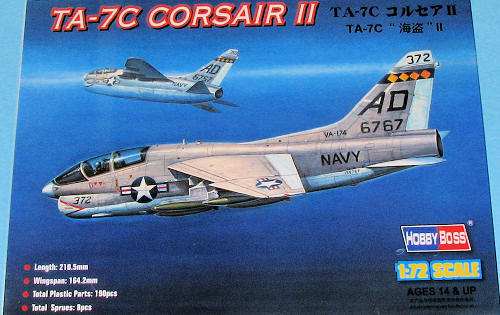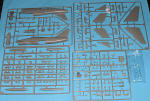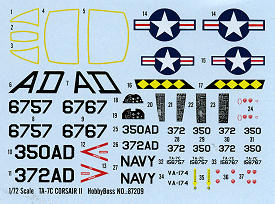
Hobby Boss 1/72 TA-7C Corsair II
| KIT #: | 87209 |
| PRICE: | $29.05 from GreatModels |
| DECALS: | Two options |
| REVIEWER: | Scott Van Aken |
| NOTES: | Only injected TA-7 made |

| HISTORY |
The A-7 itself was designed as a replacement for the long-serving A-4 Skyhawk. Among the requirements were greater armament capabilities and a higher speed. The aircraft was also designed for ease of maintenance, especially the avionics equipment, which was accessible from external bays at ground level. So successful was the aircraft, that the USAF once again delved into Navy territory and made large scale purchases of the airframe as the A-7D. This included several upgrades which the Navy took into consideration for its final attack variant, the A-7E. All A-7s were gone from the inventory by 1993, having made their last cruise during Desert Storm and replaced by the F-18 Hornet.
The subject of this kit is the two-seat trainer version for U.S. Navy, 24 converted from A-7B, 36 from A-7C. These were farmed out to the two A-7 training units, VA-122 for the west coast squadrons and VA-174 for east coast operators. In 1984, 49 airframes, including the 8 EA-7Ls, were re-engined with the TF41-A-402 and upgraded to A-7E standard.
| THE KIT |
 Hobby Boss has built a bit of a reputation for themselves over the last year or two. They have done a series of relatively easy to build aircraft at a reasonable price. They also seem to have several shape and other errors with each kit they do. Their smaller single engine prop planes generally come with a cockpit that stops at the instrument panel. Some of their other kits are missing things (like a tail hook with the 1/72 F-18s) that other companies would not dare forget. Yet they are also designed to be relatively quick builds and their engineering tends towards the robust end of things.
Hobby Boss has built a bit of a reputation for themselves over the last year or two. They have done a series of relatively easy to build aircraft at a reasonable price. They also seem to have several shape and other errors with each kit they do. Their smaller single engine prop planes generally come with a cockpit that stops at the instrument panel. Some of their other kits are missing things (like a tail hook with the 1/72 F-18s) that other companies would not dare forget. Yet they are also designed to be relatively quick builds and their engineering tends towards the robust end of things.
Just looking over this TA-7 kit shows me that Hobby Boss want this series of A-7s to be more for the enthusiast than the easy build crowd. The attachment points of various parts are more in line with 'standard' injection molded kits in that the tabs and slots are not huge. An inspection of the parts shows nicely done engraved panel lines and rivet detail. It also shows quite a few sink areas on things like outer landing gear doors. Some of the features are pronounced when they should be flush, and I'll point to the HF antenna area on the forward fin and the power connection hatch on the aft fuselage as two of those. The kit does include the avionics bay on the left and right side, though on Navy planes, these were more often seen closed unless work was being done. I only mention that as this kit seems to have all the bits to do the USAF TA-7K as well.
The cockpit is well done though some will want to replace the rather generic seats with something that has more detail. The kit also includes a long intake trunking that incorporates the nose gear well. It will have a large seam that will be a challenge to eliminate. Navy A-7s often wore a bag-like intake cover when not being readied for flight. The kit includes a full array of weapons though the TA-7C rarely carried them when on standard training flights. Usually the two fuel tanks were it if that. These were weapons capable as they were used to practice weapons delivery from time to time, but most often carried 'blue blaster' 25 pound practice bombs rather than full size weapons. I'd leave off the Sidewinder rails.
when on standard training flights. Usually the two fuel tanks were it if that. These were weapons capable as they were used to practice weapons delivery from time to time, but most often carried 'blue blaster' 25 pound practice bombs rather than full size weapons. I'd leave off the Sidewinder rails.
Instructions are straight-forward with well illustrated construction steps that provide Gunze color references. Markings are for two planes from VA-174, the east coast A-7 training unit. These markings options differ only in serial number and nose numbers with both planes in gloss light gull grey over white. The decal sheet is well printed and my experience with Hobby Boss decals has been positive so these should work well. I particularly like that they have included the yellow canopy seals, something that Academy did with their F-8 that was much appreciated. You can see that instruments are decals.
| CONCLUSIONS |
I've heard mutterings that the nose section on this kit is off. Well, it looks OK to me, but I'll withhold judgment on that until after I've built it. I can tell you that the parabrake housing that comes with the kit is far too small in diameter. This is one of those aircraft for which I've waited for a nice kit for many years. Long ago I built one using a conversion and while it was satisfactory, it wasn't as nice as I'd have liked. This just has to be better!
December 2008
You can get this and many other neat kits and accessories at GreatModels
If you would like your product reviewed fairly and fairly quickly, please contact the editor or see other details in the